2025 NBA Draft Big Board 3.0
We’re a few weeks away from selection Sunday while passing the NBA trade deadline. With the board of selecting teams shaping up, it’s time to update my rankings on each prospect.
Introduction
Note: I only rank the prospects I watch. The board itself is based on a combination of a feasible role and thus how worthy that role is and the long-term potential. This aligns with how most front offices approach the draft. Let’s begin!
The First Round
1. Cooper Flagg — Duke
Combo Forward — 6’9” — 205 lbs — Freshman
Flagg is one of the best defensive prospects of the last few years. His offense followed up quickly, considering all on-ball improvements. Duke’s one of the best teams in college, and Flagg is the main reason for that. Looking at this NBA trajectory, teams will likely continue to build around him. Therefore, a rebuilding team winning the lottery would be in his best interest. I expect Flagg to be an All-NBA caliber player in his prime with multiple All-Star appearances throughout his career.
2. Tre Johnson — Texas
Combo Guard — 6’6” — 190 lbs — Freshman
Scaling down his offensive role is a challenge for his NBA team. Regardless, Johnson is still growing in his shot selection and approach as Texas’ main scoring option. He’s often forcing the game rather than playing within the flow of the game. Regardless, Johnson shows serious number-one option caliber play as late, with his top-tier perimeter shooting being the base for him to invest in his scoring prowess in the next few years.
Due to the Longhorns’ questionable roster construction, he isn’t in the best place to showcase his playmaking, which was seen more in his high school footage. Therefore, I expect NBA front offices to tap into that untapped potential to make Johnson their point guard of the future. In terms of flashes, he has shown to be potentially one of the best guards in this class, with his positional size, defensive improvements, and toughness being the main intangibles feeding a likely team-leading role in his prime; a clear top-3 talent.
3. Dylan Harper — Rutgers
Point Guard — 6’6” — 215 lbs — Freshman
Very few prospects in this class have a better feel for the game than Harper. He’s the son of a five-time NBA champion, Ron Harper, and what immediately stands out in Dylan’s game is his combination of size, strength, and the natural process of how he sees the game. His quick decision-making as a passer shows the ability to get downhill both on craft and by using his strength. He’s an elite finisher at the rim, with a combination of creativity and soft touch.
With multiple 30-point-plus scoring outbursts, most of them inside the paint, Harper’s game already translates. That puts him firmly ahead of his peers, making him a lock to be a top-5 selection this summer.
4. Ace Bailey — Rutgers
Power Forward — 6’10” — 200 lbs — Freshman
The purest shot-maker I’ve evaluated over the last few years. Bailey’s ability to impact the game with his endless possibilities as a shooter and rebounder fuels his potential stardom. But there’s a risk in his profile. Despite playing too freely at Rutgers, he has improved immensely regarding his processing of the game. There’s a long road ahead before he can be a team’s main scorer while impacting the game defensively. His lack of aggressiveness in getting downhill becomes much less as the season progresses, making future improvements more feasible. NBA teams know how to develop such gifted talent. Therefore, I see little risks, making him a clear-cut top-5 selection.
5. V.J. Edgecombe — Baylor
Combo Guard — 6’5” — 195 lbs — Freshman
Edgecombe’s elite athleticism is the main sell. He’s still figuring out his role, as he lacks true guard skills to be a point guard. Despite the aforementioned athletic traits, Edgecombe’s measurements at the NBA Draft Combine will determine a chunk of his draft value.
It’s hard to unsee his stellar performances with the Bahamas in their fight to qualify for the Olympic Games. He seamlessly played alongside seasoned NBA veterans while putting his scoring prowess on display by utilizing his elite athletic tools. That will earn him a reputation as a 20-point-plus scorer in the league.
On top of that, his feel for the game immediately stood out, making the right decisions as a team defender in rotations. NBA front offices buy a two-way player if everything goes according to plan with his development. That warrants a high draft pick in this loaded class.
6. Derik Queen — Maryland
Center— 6’10” — 245 lbs — Freshman
I was wrong about Queen! I left him unranked in my previous two versions due to not watching him closely after the McDonald’s game. His production feels feasible for the NBA, especially slimming down his weight. His level of impacting the game in the frontcourt on both ends warrants a starting-level role in an era where four, or even five-out-styled offense will become the norm. Despite recent inconsistency in his performance, Queen’s high feel for the game with much more consistent execution puts less value in some of the inefficient numbers he has been putting on.
His mobility will continue to benefit from him changing his body until he reaches a point where he can bank in on his physical tools. The lack of rim protection is an early concern that he will continue to address. However, his potential scoring on all three levels from the five-spot changes the entire dynamic of his profile. Despite fewer NBA teams playing in a two-big setup, I expect his drafting team to properly build around him while putting out a more frontcourt-heavy roster to complement his qualities in the next few years.
7. Noa Essengue — ratiopharm Ulm
Combo Forward — 6’10” — 194 lbs — 2006
Essengue has all the tools to be a high-end scoring wing in the NBA. Compared to his peers, he might need to most time to develop into a starter. However, that doesn’t take away much of his draft value, as his complete package of tools and physical traits give NBA decision-makers an almost blank blueprint that they can fill in as they wish.
At times, Essengue doesn’t show the best body language. He can play carelessly and often struggles to adjust to a faster-paced game. In terms of his team defense, that’s the area of development. However, to support the claim of his future improvement, he’s already a consistent shooter in motion and mechanics. Has shown the ability to keep the ball high on catch-and-shoot attempts. That can make him an effective shooter off the catch in a faster-paced NBA game. That’s the base.
He’s tough, aggressive, and looks to execute reads quickly. His game is built for a faster NBA game. His archetype as a plus-sized wing that’s what will lead to a higher draft value. Essengue uses his footwork well to impact the defense. Combined with his good passing, he can be an all-around wing in his prime, impacting the game with his production. To solidify his top-ten status, his body language and team defense need to improve on top of the need to strengthen in the next few years.
8. Dink Pate — Capitanes de Ciudad de México
Point Guard — 6’8” — 210 lbs — 2006
Despite an overload of guard talent in the NBA, Pate offers the unique blend of natural playmaking skills, plus size at 6-foot-8 while having an all-rounded offensive game. As a 17-year-old, Pate has shown that he can handle the physicality of professional basketball in the second stage of last year’s G League season.
Pate continues to get his reps at the highest level, this time playing for a team aiming to win a G League title. What sets Pate apart from his peers is the combination of well-improving live-dribble decision-making while offering a blend of great athleticism that can elevate his scoring to all three levels. Pate’s biggest improvement is his footwork, opening up a path to maximize how he utilizes his burst.
If everything clicks, Pate can play a paint-touch-generating floor general who can carry a large chunk of his team’s scoring load. That’s the key to earning many ball touches and high usages on an NBA floor.
9. Jeremiah Fears — Oklahoma
Combo Guard — 6’4” — 175 lbs — Freshman
Fears is one of the most offensively gifted prospects of the last few years. Despite putting up highly efficient scoring numbers, the development of his body will determine how quick he can reach the status of a 20-plus-point scorer in the NBA. Despite high steal numbers, Fears’ defensive rotations remain an issue he’s continuing to work on developing. His offensive creativity, handles, and fearless game make him one of the best offensive options in the draft class.
I expect his drafting team to invest in his defense while he’s continuing to improve the execution of his passing reads. Despite making high-risk, high-return passes, he’s often forcing the issue, leading to many turnovers. However, the context behind these is flashes of making the right reads, where his execution efficiency will determine how long teams are comfortable with him playing as the team’s leading ball handler. In the best-case scenario, Fears will ascend to becoming an All-Star fairly quick into his NBA career.
10. Khaman Maluach — Duke
Center — 7’2” — 250 lbs — Freshman
You don’t often see a utility player being a top-ten pick. However, in Maluach’s case, his tantalizing physical tools contain fluid hip mobility and excellent verticality. He’s an excellent rebounder who expanded his range to three-point territory. Maluach has a consistent shooting form that needs work, but regardless of his size, he’s good at moving without the ball, improving his perimeter game. The NBA is changing, and four and even five-out schemes are becoming more vital.
That increases the importance of floor-stretching big men who can anchor an interior when needed. That’s Maluach’s game. Despite him being a utility player, he’s a vital building block to change a good team to potentially a great championship-contending team. The most vital area of development for him is to improve as a passer and decision-maker with the ball in his hands. If he can evolve into a reliable ball-mover, it will open up the entry passes he will get on an NBA floor. That will make him more dangerous as a three-point shooter, which is currently his only NBA-translatable trait on offense.
11. Collin Murray-Boyles — South Carolina
Power Forward/Center — 6’7” — 240 lbs — Sophomore
Murray-Boyles is in an interesting position. He’s been put in a box as a non-shooting undersized forward but can be seen as one of the more unique prospects of the last few years with a game that’s built to play four or five-out basketball.
Some NBA players can succeed without shooting, and he’s one of them. He has a tremendous physical profile. He stands out both with his mobility (hips, lateral quickness) and toughness (strong frame, broad shoulders, and aggressive style of play). That’s what NBA decision-makers look for to make it feasible a prospect will offer the same amount of physicality against NBA-caliber big men while switching to smaller and quicker guards and wings.
Offers great defensive versatility by guarding both roll men and ball handlers in the pick-and-roll while being able to switch to all positions when defending off the ball. The only area of development here is to not over-help on the defensive end, leading to late rotations. Despite being a non-shooter, Murray-Boyles shows incredible efficiency near the rim.
The role I see for Murray-Boyles is as a team-connecting four who can produce his points as an active cutter and face-up scorer. His passing is one of the best traits in potential, but he has to figure out a healthy balance of chasing his baskets and creating for others. There were many cases of him passing up on open three-pointers to force tough two-pointers instead.
12. Asa Newell — Georgia
Power Forward/Center — 6’11” — 220 lbs — Freshman
Many franchises are looking for their new five-man. Traditionally, their scouts value a high feel for the game, intangibles to build in a proper role and physical tools. Newell’s motor is at the top of this class. His great rebounding ability has more value due to his active cutting. He’s a double-digit scorer without the ball in his hands, impacting the game with his energy on both ends.
The free-throw shooting is underwhelming, and that’s his area of development for the next few years. He’s decent as a passer but not good enough to make him a reliable hub in the interior. That’s the investment Golden State makes by picking him in the lottery. We’ve seen the Warriors invest heavily in their draft selections, and that’s the best context for Newell to be in.
13. Egor Demin — Brigham Young
Point Guard — 6’9” — 185 lbs — Freshman
As a true 6-foot-9 playmaker, Demin’s role is to complement the stars around him. Roster construction that gives importance to size and future potential makes Demin the ultimate candidate. Demin’s adjustment to the NBA should be quick, as the NBA-branded style of running multiple variations of the pick-and-roll is working to perfection in Demin’s early-season schedule.
The natural feel for the game in his live-dribble decision-making is at a high level. We’ve often seen European guards struggle to adapt to the NCAA’s athleticism. His inefficiency from the floor shouldn’t be an issue for NBA scouts, as they focus on the bigger picture. As a teenager, Demin’s pick-and-roll playmaking and decision-maker is among the best in the entire basketball world. How fast his offense translates to the NBA has a big share in succeeding at the next level.
14. Rasheer Fleming — Saint Joseph’s
Combo Forward — 6’9” — 230 lbs — Junior
Fleming is everything today’s positionless basketball looks for to fill the four spot. He’s an incredible passer, and Fleming has the mobility of a wing that’s a few inches shorter. His three-point shot got better this season, opening up the opportunity to play as a closeout attacking forward who can increase his three-point volume while defending against the two, three, and four positions.
Despite being an upperclassman, Fleming is young and has enough years to come where he can continue to add to his game and fully unleash his potential. He's potentially an elite role player who will continue to develop and find his niche to have a ten-plus-year career in the association.
15. Thomas Sorber — Georgetown
Center — 6’10” — 255 lbs — Freshman
Sorber caught many people by surprise, including myself. I had him on my watchlist, but not high enough. His hot start to the season forced me to dive deeper into his game and how it can translate to an NBA role. The biggest sell is his outstanding passing ability and excellent hip fluidity. He has great footwork and seals easily off opponents in the post, with a great touch to show.
With his strong build, he’s another piece in the league's revolutionizing positionless basketball buildup while spamming four, or even five-out schemes. The sample size of his shooting increases. That’s a bonus. Sorber’s interior defense, passing, and physical presence make it possible for him to stay in the league for a long time without shooting jumpers.
16. Kasparas Jakučionis — Illinois
Combo Guard — 6’6” — 200 lbs — Freshman
Jakučionis has been a tough evaluation for me. It’s easy to take his efficient numbers at face value, but contextualizing it to an NBA role that’s feasible remains a challenge. However, continuing to dig into his game had me conclude I wasn’t valuing his physical tools enough. While I don’t believe in him being a pure point guard, Jakučionis’ shot-making and complete playmaking package gives him enough substance to be a long-term starter in the NBA.
Scaling down his ball touches is a risk, as he needs the ball in his hands to succeed. The other side of the coin is the high level of turnovers, which are a result of him being forced to dictate the game for Illinois, making it easier for opponents to force him to make mistakes. His combination of craft, offensive creativity, and handles form the base to change his offense to a two-handed finisher, which he needs to add to his game to succeed in fully compensating for his lack of physical tools and athleticism. A higher risk but a much higher reward potentially for his drafting team.
17. Ian Jackson — North Carolina
Shooting Guard — 6’6” — 185 lbs — Freshman
The Tar Heels are a true blue blood program. But not one that prioritizes underclassmen to fully develop in their system. In an underwhelming season, Jackson is their sole positive. His scoring prowess and quickly developing shot-making give him a cushion to continue to play the way he does when he makes the step to the NBA.
Physically, he has a lot to develop. He has a thin frame but broad shoulders to continue to build up muscle in the next few years. I expect Jackson to transform his game into a slasher, with his handles, creativity, and soft touch at the rim being the main sell. His shot-making will be the base to support a team’s offensive rating. The lack of passing is a result of North Carolina’s isolation-heavy game, as they lack positional. That forces them to outscore teams, putting Jackson in a good spot to show his talent. Context matters, and that’s the challenge with Jackson regarding determining a clear role for him. Regardless, his level of offense is a clear reason to draft him within the top 20.
18. Carter Bryant — Arizona
Small Forward — 6’8” — 215 lbs — Freshman
His early-season production at Arizona makes it questionable for Bryant to be a one-and-done prospect. But that changed during conference play. As a switchable and versatile defender at 6-foot-8, Bryant’s role as a slashing and shooting wing with a soft touch at the rim gives him a clear role. That gains value, considering how well he can defend against multiple types of opponents.
His long wingspan and frame with room left to add muscle and overall level of talent will have many teams willing to take a bet on him. His excellent defensive awareness and explosiveness on the offensive end make Bryant fit in a much-wanted blend of wing-defending threes who can consistently make shots while impacting the game with his rebounding. I don’t see any reason why front offices won’t be willing to bet on the teenager’s long-term potential.
19. Liam McNeeley — Connecticut
Small Forward — 6’7” — 210 lbs — Freshman
When looking for prospects with a high floor and specific untapped potential, McNeeley is among the top. He’s one of the top shooters in this class with the potential to evolve into a two-level scorer after utilizing the most out of his solid athleticism. He has a great physical profile with broad shoulders, a well-filled frame, and great upper-leg strength. That helps him to fluidly move his hips and potentially serve as a point-of-attack defender on an NBA floor. When considering that he’s built to play as a three and a four, that’s a trait that will intrigue NBA decision-makers.
He’s an effective finisher at the rim but struggles to get downhill when he cannot rely on his physicality. In college basketball, that will be his challenge. Coach Hurley will use him as a specific part of their system, thus making it likely he has to sacrifice some of the things he can do to fit in at college basketball’s hottest team of the last few years. Knowing that NBA scouts value high school film, the emphasis to solidify his status as a top-20 pick will be mainly on production combined with defensive impacts. McNeeley is a high-floor prospect who can develop into a niche and be one of the favorites to earn at least two contract extensions throughout his NBA career.
20. Miles Byrd — San Diego State
Shooting Guard/Small Forward — 6’7” — 195 lbs — Sophomore
Despite being a sophomore, Byrd shows many flashes of a scalable NBA game where Byrd can serve as the second guard while playing in a reduced role with fewer ball touches as a shooting and closeout-attacking wing. The Aztecs’ defensive principles are instilled in his game. I expect him to show a complete package of supportive playmaking, scoring via slashes while serving as a pick-and-roll defender. That holds value in today’s era, where more NBA front offices construct their roster with positional size and two-way versatility.
21. Nolan Traoré — Saint-Quentin
Point Guard — 6’4” — 175 lbs — 2006
Traoré is a classic European guard with a modern NBA touch. He’s a very creative ball handler who masters angle creation using his craft and footwork. He’s not an explosive athlete but looks to deceive defenders by utilizing his footwork to perfection. The reason why he falls outside of my lottery is due to the lack of size combined with the need to get stronger in the next few years.
He struggles to consistently defend against non-guards, which will be the case on a nightly basis on an NBA floor. To make it work, he needs the ball in his hands. Compared to the aforementioned leading guards, Traoré doesn’t have the same promise as a three-point shooter, which will eventually hurt the biggest value he has as a scorer.
Despite the lack of explosiveness, Traoré will always get to the rim while relying on his creativity, change of pace, and craft. However, without much of a threat from three-point land, it will toughen the ability to solidify himself as an interior scorer. That combined with the ball-dominant character of his game, NBA decision-makers will be hesitant to give him the ball touches and usage to help him develop into a starting-caliber point guard. Regardless, Traoré is a top-ten-level prospect who can change his draft stock to the positive by showing he can be a consistent pull-up shooter from three while improving off the catch.
22. Hugo González Peña — Real Madrid
Shooting Guard/Small Forward — 6’6” — 210 lbs — 2006
González Peña fits the mold of the plus-defending wing shooter. He’s a versatile offensive option whose base is serving as a ball-moving closeout attacker and volume shooter. The top-20 value is created by his ability to lock down up to three positions, as he’s mostly focused on guards and wings.
The biggest question mark surrounding his long-term potential is the ability to be a self-creating scorer in the NBA. Prospects such as González Peña often ‘fool’ the American public because they fail to contextualize the system he’s in. Spain is one of the top-performing European countries due to the consistency of their system.
All age groups play in the same system as the senior national team does, which makes it clear and easy for players to recognize and play their roles. The downside of this all is the lack of expressing their creativity. The ability to put up numbers and be creative against American-caliber athletes is what González Peña needs to answer this upcoming season. Therefore, his playing college basketball would have been a draft-stock booster rather than staying in Europe.
23. Joson Sanon — Arizona State
Shooting Guard — 6’4” — 175 lbs — Freshman
Sanon is a complete scoring guard. At 6-foot-5, he has excellent positional size to serve both as a leading and combo guard. What immediately stood out was the excellent elevation of his jumpers. He’s a maestro in changing his pace. That’s the base for his scoring. Sanon is a creative scorer who uses flair, craft, and great burst to create separation from defenders. He can pull up from everyone on the floor, where he’s more comfortable to serve as a pull-up three-point shooter.
The Sun Devil is an improving playmaker. He can be too selfish, as he's looking to chase his buckets rather than setting up others. However, I expect Coach Hurley and his staff to continue to use Sanon as a scoring guard, where his ability to play as a ball-mover will be a crucial aspect of his development. Sanon looks like he can average double-digit points in the NBA as of today, but he needs to put things together as a creator for others to fully bank on his potential.
24. Mackenzie Mgbako — Indiana
Power Forward — 6’8” — 215 lbs — Sophomore
It does not take much research to find out Mgbako is struggling with Indiana’s weird roster construction. He’s best to play as a four, but he didn’t get enough of these minutes as the Hoosiers had to play two centers last year. Mgbako has had some great performances this year in his role as a four, where his shot-making, physical tools, plus size make him an intriguing prospect for every NBA team. He’s an ultimate depth piece. The league’s top-notch role players are becoming much more expensive, thus making a high first-round pick a realistic price.
25. Sergio De Larrea — Valencia Bsket
Point Guard — 6’6” — 2005
Despite more American scouts targeting the European market, they still fail to recognize all the talent on the continent. De Larrea has the mature game, craft, and, more importantly, top-notch ball handling and pick-and-roll playmaking to hang his hat on. His game is focused on creating good looks for others, where he’s best to thrive with a good screening and play-finishing center.
26. Johann Grünloh — Rasta Vechta
Power Forward/Center — 6’10” — 220 lbs — 2005
Grünloh is one of the top center prospects in this class. No doubt. His value as a screener, ball-mover, shooter, and overall complementary value when playing away from the ball makes him a starting caliber big man, hence the close to top-20 value I see in him.
While emerging on the European youth scene, Grünloh is playing as a reliable under-the-basket defender, screener, and play-finisher in Europe. What makes him a valuable piece for NBA decision-makers to keep an eye on is his maturity for his age. He’s vocal and doesn’t shy away from playing as a leader. He’s also an effective big man who finishes with both hands and shows a soft touch at the rim.
Having good hands was a must-have to play as a five, and due to the league’s increasing need for ball movement and passing, that continues to be the case, marking that as one of his better attributes.
27. Kam Jones — Marquette
Combo Guard — 6’5” — 200 lbs — Senior
Jones has a clear path to win National Player of the Year. He stayed loyal to Marquette for years, and now he shows he can lead the team to glory as they are the highest-ranked program in the Big East. His scalable guard play makes him the ultimate depth piece where he can grow into a steady starter leading an offense while also being able to take over a game as a microwave scorer. The rare combination of top-tier playmaking on top of scoring and steady team defense warrants a first-round selection for the senior guard.
28. Andrej Stojaković — California
Shooting Guard/Small Forward — 6’7” — 190 lbs — Freshman
Wing-sized ball handlers with offensive creativity, scoring touch, and secondary playmaking look to fit what teams surround their stars with. Stojaković didn’t put himself in the best position to succeed at Stanford, but his move to California made him seamlessly take over the large chunk of usage that was left on the table. I expect Stojaković to continue to develop as a pick-and-roll ball handler, which gives him a complete scoring package while having the physical tools, foot speed, and consistent rotations to ensure a role as a key role player off the bench. In terms of long-term upside, I don’t expect him to start in the future, but instead to develop into a niche role.
29. Joan Beringer — Cedevita Olimpija
Center — 6’9” — 2006
The NBA needs uber-athletic rim-running play-finishers. Teams are betting on long-term potential with Beringer, who’s one of the best screening fives in this class. With teams valuing four, or even five-out-styled brands of basketball, Beringer’s biggest swingskill is his development as a passer and playmaker. I expect him to be one of the league’s better interior options as he’ll continue to grow into his body while supporting a team’s defensive rating with his stellar defense in the pick-and-roll. His long wingspan, light feet, and great mobility might even make him rise on draft boards as the season progresses.
30. Adou Thiero — Arkansas
Combo Forward — 6’8” — 222 lbs — Junior
To understand the logic behind this selection, you must go back to Thiero’s freshman season and the strides he made in the process. His body continuously changed. He’s a unique prospect, with the limitless potential his physical tools give him.
Despite being a junior, NBA teams still need to treat Thiero as a long-term project. He has the chance to be an impactful starter with his bolstering physical tools, improving self-creation as a scorer while being a much better shooter compared to the last two seasons. Thiero comes as a complete prospect who needs to adjust to the continuous change of his body.
The Second Round
31. Ryan Kalkbrenner — Creighton
Center — 7’1” — 260 lbs — Senior
32. Ben Saraf — Elitzur Kiryat Ata
Combo Guard — 6’6” — 2006
33. Owen Freeman — Iowa
Power Forward/Center — 6’10” — 230 lbs — Sophomore
34. Rocco Zikarsky — Brisbane
Center — 7’2” — 227 lbs — 2006
35. Nique Clifford — Colorado State
Shooting Guard/Small Forward — 6’6” — 200 lbs — Senior
36. Elijah Mahi — Santa Clara
Small Forward — 6’7” — 220 lbs — Junior
37. Neoklis Avdalas — Peristeri BC
Combo Guard — 6’8” — 185 lbs — 2006
38. Michael Ajayi — Gonzaga
Combo Forward — 6’7” — 228 lbs — Junior
39. Brooks Barnhizer — Northwestern
Shooting Guard/Small Forward — 6’6” — 215 lbs — Senior
40. Noah Penda — Clermont-Vichy
Power Forward — 6’8” — 2005
41. Otega Oweh — Kentucky
Shooting Guard — 6’5” — 210 lbs — Senior
42. Michael Ruzic — Joventut Badalona
Combo Forward — 6’10” — 2006
43. Will Riley — Illinois
Combo Guard — 6’9” — 175 lbs — Freshman
44. Kon Knueppel — Duke
Shooting Guard — 6’6” — 205 lbs — Freshman
45. Darrion Williams — Texas Tech
Combo Forward — 6’7” — 225 lbs — Junior
46. Maxime Raynaud — Stanford
Center — 7’1” — 250 lbs — Senior
47. Labaron Philon — Alabama
Combo Guard — 6’4” — 177 lbs — Freshman
48. Mouhamed Faye — Reggio Emilia
Center— 6’10” — 2005
49. Hunter Sallis — Wake Forest
Combo Guard — 6’5” — 185 lbs — Senior
50. Saint Thomas — USC
Shooting Guard/Small Forward — 6’7” — 200 lbs — Junior
51. Magoon Gwath — San Diego State
Power Forward/Center — 7’0” — 195 lbs — Freshman
52. Malique Lewis — South East Melbourne
Shooting Guard/Small Forward — 6’8” — 205 lbs — 2004
53. Donovan Dent — New Mexico
Point Guard — 6’2” — 180 lbs — Junior
54. Dailyn Swain — Xavier
Shooting Guard/Small Forward— 6’7” — 200 lbs — Sophomore
55. Jacksen Moni — North Dakota State
Power Forward/Center — 6’10” — 225 lbs — Senior
56. Berke Büyüktuncel — Nebraska
Power Forward — 6’9” — 205 lbs — Sophomore
57. Tyson Degenhart — Boise State
Power Forward— 6’8” — 235 lbs — Senior
58. Yaxel Lendeborg — UAB
Power Forward/Center — 6’9” — 230 lbs — Senior
59. Bogoljub Marković — Mega Basket
Power Forward— 6’11” — 195 lbs — 2005
60. Cedric Coward — Washington State
Combo Guard/Small Forward — 6’6” — 205 lbs — Junior
Why Subscribe to Ersin’s NBA Draft Newsletter?
I've set some incredibly ambitious goals for the 2025 NBA Draft Cycle:
My plan is to provide you with 125+ in-depth scouting reports to ensure you're completely prepared for draft night.
But wait, there's more! I'll keep you in the loop with ongoing college basketball coverage, spotlighting those promising JUCO prospects. This means you won't be surprised when a lesser-known player makes waves in D1 or even steps up to the NBA.
Here's what you'll get:
Thorough 3,000+ word scouting reports delivered to your inbox
Big Boards and Mock Drafts
Exclusive insights into players from the less-highlighted conferences and levels of college basketball
And plenty more!
Join this exciting venture by subscribing for just $5 a month or save with our annual plan at $50, effectively giving you two months free.




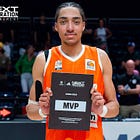
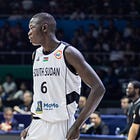

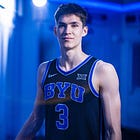


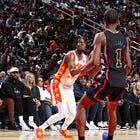

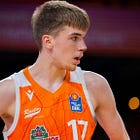
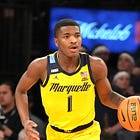
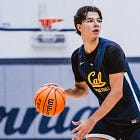
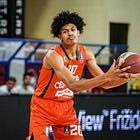
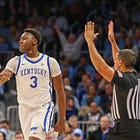
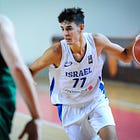
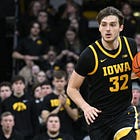
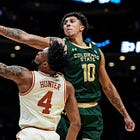
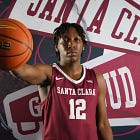

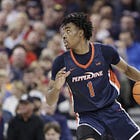
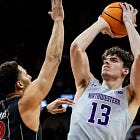
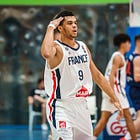
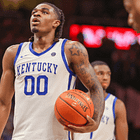
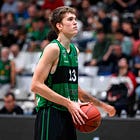
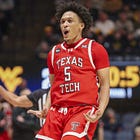
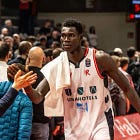




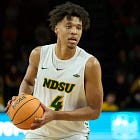
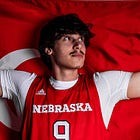





Awesome job man great information
Thanks for the updated big board, Ersin! I am trying to get there on Pate but I just don’t see the floor general / passing genes in him. Do you have any recent clips showcasing this talents there? I’d love to see it.